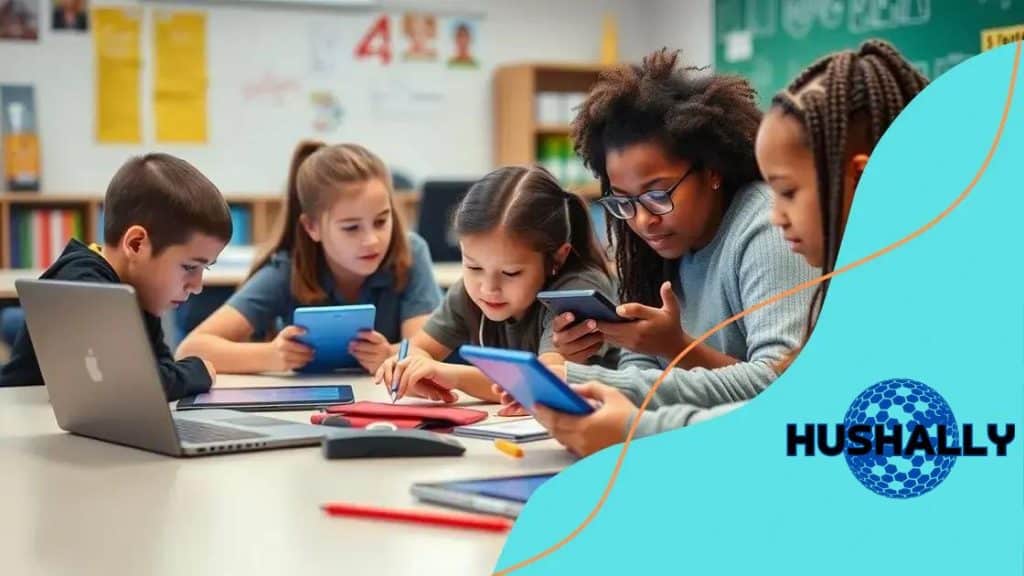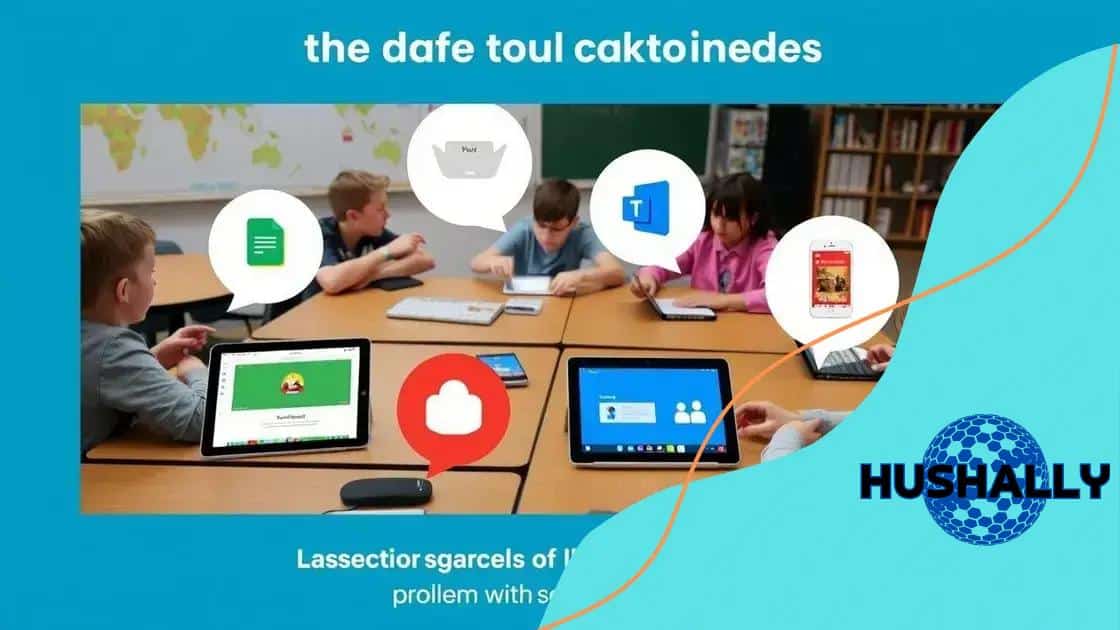Collaborative digital classroom tools transform learning

Collaborative digital classroom tools enhance learning by promoting student engagement, fostering collaboration, and providing educators with resources to effectively manage and track progress in the classroom.
Collaborative digital classroom tools are reshaping how we perceive education today. They not only boost students’ engagement but also foster a sense of community in learning. Curious about how these tools can transform your educational experience? Let’s dive in!
Understanding collaborative digital classroom tools
Understanding collaborative digital classroom tools is crucial for modern education. These tools bring together students and teachers in unique ways, fostering a vibrant learning environment. They enable students to work together, share ideas, and create projects, regardless of where they are.
Key Features of Collaborative Tools
Many classroom tools come with distinctive features designed to enhance collaboration. Some of these include:
- Real-time collaboration: Students can work together on projects simultaneously.
- File sharing: Easy sharing of documents, images, and videos among team members.
- Interactive discussions: Platforms that support chat and video calls for communication.
As we explore these tools, it’s clear they support a social learning model. By allowing students to engage actively with their peers, these tools build essential 21st-century skills. Notably, they help cultivate teamwork, critical thinking, and effective communication.
Popular Collaborative Tools
There are several effective tools commonly used in classrooms today, each with its unique functionalities. Here are a few:
- Google Classroom: A platform that integrates various Google tools for easy assignment management.
- Padlet: An interactive wall for sharing ideas and resources.
- Microsoft Teams: Offers collaboration through chat, video meetings, and shared files.
These tools not only facilitate collaborative learning but also encourage creativity and innovation among students. By using collaborative digital classroom tools, educators can create more inclusive and engaging educational experiences.
Benefits for students and educators
The benefits for students and educators that come from using digital classroom tools are significant. These tools not only enhance the learning experience but also make teaching more effective. Students are more engaged when they can collaborate digitally, sharing ideas and learning from one another.
Enhanced Engagement
One major benefit is the increased engagement among students. Traditional methods can sometimes lead to passive learning, but with collaborative tools, students take an active role in their education. This active involvement makes learning enjoyable and memorable.
- Interactive lessons: Digital tools offer interactive elements that keep students interested.
- Peer learning: Collaboration fosters a sense of community among students.
- Immediate feedback: Teachers can provide prompt responses to student queries.
Furthermore, these tools allow educators to track student progress more accurately. By analyzing data from collaborative activities, teachers can identify areas where students may need extra help. They can tailor their teaching strategies accordingly, leading to improved outcomes for all students.
Flexible Learning Environments
Another advantage is the flexibility these tools provide. Students can learn from anywhere, making education more accessible. Whether in the classroom or at home, they can connect and collaborate with their peers. This flexibility helps accommodate different learning styles and schedules.
The use of digital classroom tools also encourages creativity among students. They can produce unique projects and explore new concepts that might not be covered in a traditional classroom setting. In such dynamic environments, both students and educators can thrive.
Popular tools and their features

Many popular collaborative digital classroom tools have reshaped how students and teachers interact. Each of these tools offers unique features that enhance the learning experience. Understanding these features helps educators choose the right tool for their needs.
Google Classroom
Google Classroom is widely used for its integration with various Google services. This platform makes it easy to create and manage classes, distribute assignments, and communicate with students. It allows:
- Simple assignment tracking: Teachers can easily see which assignments are submitted.
- Collaboration with Google Docs: Students can work together on documents in real-time.
- Resource sharing: Easy sharing of learning materials such as videos and links.
By using Google Classroom, teachers can save time and keep their students organized, making it a popular choice in many schools.
Padlet
Padlet is another effective tool that offers a visually engaging space for students and teachers. Users can create “walls” to share ideas and resources. Key features include:
- Customization: Users can modify their walls with themes and formats.
- Media integration: Students can add images, videos, and links easily.
- Collaborative brainstorming: Everyone can contribute ideas on the same board.
This tool stands out for facilitating brainstorming sessions and interactive discussions among students.
Microsoft Teams
Microsoft Teams is designed for collaboration and communication. It is particularly beneficial for video conferencing and group projects. Some of its features include:
- Chat functionality: Students can message each other for quick communication.
- File sharing: Documents can be shared and edited directly within Teams.
- Integration with Office apps: Seamless access to Word, Excel, and PowerPoint.
This powerful platform supports both remote and in-person learning, making it a versatile choice for educators.
By exploring these popular tools, educators can enhance classroom engagement and foster a collaborative atmosphere. Each tool has distinct benefits, allowing for flexibility in teaching and learning.
Tips for effective implementation
Implementing collaborative digital classroom tools effectively can enhance learning experiences significantly. There are several key strategies to consider to ensure these tools are used to their full potential.
Plan Ahead
Before introducing new tools, it’s important to have a clear plan. This includes identifying the needs of your students and how the tools can address them. Consider the following:
- Set clear objectives: Define what you want to achieve with each tool.
- Choose appropriate tools: Select tools that align with your learning goals.
- Provide training: Ensure that both teachers and students understand how to use the tools effectively.
Planning your approach will help integrate these tools smoothly into the classroom environment.
Encourage Collaboration
One of the primary benefits of digital tools is enabling student collaboration. Encourage students to work together on projects and assignments. This can be achieved by:
- Creating group projects: Assign tasks that require teamwork and collective effort.
- Using shared documents: Promote the use of shared files for real-time collaboration.
- Facilitating discussions: Use forums or chat features to encourage dialogue among students.
By fostering a collaborative atmosphere, students can learn from one another and build essential skills.
Monitor and Adapt
It’s important to regularly monitor how these tools are being used in your classroom. Gather feedback from students and be open to making adjustments. This can include:
- Surveying students: Ask what they like or dislike about the tools.
- Tracking engagement: Observe participation levels during collaborative activities.
- Modifying strategies: Be willing to change approaches based on what works best.
Adapting your implementation based on feedback ensures that the tools remain effective and relevant.
Following these tips can lead to successful implementation of collaborative digital classroom tools. It ultimately enhances the learning environment and empowers students.
Challenges and solutions in usage
While using collaborative digital classroom tools offers many benefits, challenges can arise in their implementation and usage. Understanding these challenges helps educators find effective solutions that enhance learning.
Common Challenges
One of the primary challenges is the initial resistance from both students and teachers. Some may feel uncomfortable with new technologies or prefer traditional methods. This resistance can be due to:
- Lack of training: Without proper training, educators may struggle to use the tools effectively.
- Fear of technology: Some may feel intimidated by digital tools or fear making mistakes.
- Limited access: Not all students have equal access to technology, which can create disparities.
Another challenge is keeping students engaged. While digital tools can enhance collaboration, not all students may participate fully. This can lead to uneven contributions in group activities, which may affect learning outcomes.
Effective Solutions
To address these challenges, educators can implement several strategies. First, providing adequate training is crucial. This can include:
- Workshops: Organize training sessions for both teachers and students to learn how to use the tools effectively.
- Peer support: Pair tech-savvy students with those who may need extra help.
- Resource availability: Share tutorials and guides online to assist users in navigating the tools.
Additionally, encouraging a supportive environment can help ease the transition. Teachers should focus on fostering a positive culture around technology use, emphasizing collaboration and teamwork. Regular check-ins with students can also help maintain engagement during class activities.
Lastly, ensuring equitable access to technology is vital. Schools can provide resources like:
- Loaner devices: Offering devices to students who do not have them can promote equality.
- Tech access programs: Create initiatives to help families gain access to the internet and devices.
- Flexible deadlines: Allowing extra time for students with limited access can help them complete assignments without pressure.
By addressing challenges proactively, educators can optimize the use of collaborative digital classroom tools and create an inclusive learning environment.
collaborative digital classroom tools can greatly enhance learning and teaching experiences. By understanding their benefits, addressing challenges, and implementing effective solutions, educators can harness the power of technology to create a more engaging and inclusive environment. Embracing these tools can lead to improved collaboration, greater student engagement, and better learning outcomes.
FAQ – Frequently Asked Questions about Collaborative Digital Classroom Tools
What are collaborative digital classroom tools?
They are online platforms that enable students and teachers to work together in real-time, share resources, and enhance learning experiences.
How can these tools improve student engagement?
By using interactive features and collaborative activities, students become more involved in their learning, making classes more dynamic and enjoyable.
What are common challenges in using these tools?
Some challenges include resistance to new technology, engagement issues, and unequal access to devices among students.
How can schools address these challenges?
Schools can provide training, foster a supportive environment, and ensure equitable access to technology for all students.





